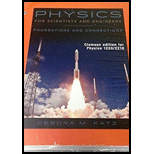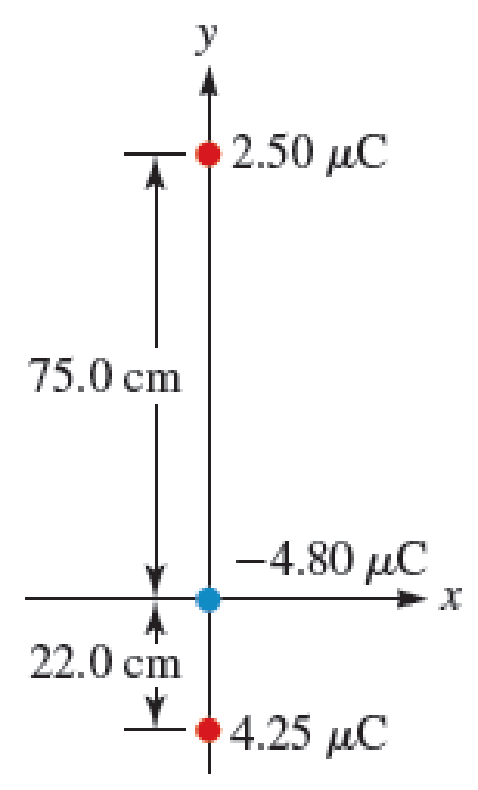
Concept explainers
Figure P24.20 shows three charged spheres arranged along the y axis.
a. What is the electric field at x = 0, y = 3.00 m?
b. What is the electric field at x = 3.00 m, y = 0?

FIGURE P24.20
(a)
The electric field at
Answer to Problem 20PQ
The electric field at
Explanation of Solution
The electric field at
Write the formula for the electric field of a spherical source.
Here,
Substitute
Substitute
Substitute
Write the expression to find the electric field at
Here,
Conclusion:
Substitute
Therefore, the electric field at
(b)
The electric field at
Answer to Problem 20PQ
The electric field at
Explanation of Solution
The figure below show the system,

The electric field at
Write the formula for the electric field of a spherical source.
Here,
Write value of
Write value of
Substitute
Substitute
Substitute
Write the expression to find the electric field at
Here,
Conclusion:
Substitute
Therefore, the electric field at
Want to see more full solutions like this?
Chapter 24 Solutions
Physics for Scientists and Engineers: Foundations and Connections
- A total charge Q is distributed uniformly on a metal ring of radius R. a. What is the magnitude of the electric field in the center of the ring at point O (Fig. P24.61)? b. What is the magnitude of the electric field at the point A lying on the axis of the ring a distance R from the center O (same length as the radius of the ring)? FIGURE P24.61arrow_forwardA solid, insulating sphere of radius a has a uniform charge density throughout its volume and a total charge Q. Concentric with this sphere is an uncharged, conducting, hollow sphere whose inner and outer radii are b and e as shown in Figure P24.45. We wish to understand completely the charges and electric fields at all locations. (a) Find the charge contained within a sphere of radius r a. (b) From this value, find the magnitude of the electric field for r a. (c) What charge is contained within a sphere of radius r when a r b? (d) From this value, find the magnitude of the electric field for r when a r b. (e) Now consider r when b r c. What is the magnitude of the electric field for this range of values of r? (f) From this value, what must be the charge on the inner surface of the hollow sphere? (g) From part (f), what must be the charge on the outer surface of the hollow sphere? (h) Consider the three spherical surfaces of radii a, b, and c. Which of these surfaces has the largest magnitude of surface charge density? Figure P24.45 Problems 43 and 47.arrow_forwardThree charged spheres are suspended by nonconducting light rods of length L = 0.625 m from the point O. The rods are fixed in position so that the middle rod is vertical and the rods on the left and right make an angle of 30.0 with the vertical (Fig. P24.50). a. What is the total electric field due to the charged spheres at point O? b. What is the electric force on a particle with charge q = +5.00 C placed at point O? FIGURE P24.50arrow_forward
- A uniformly charged conducting rod of length = 30.0 cm and charge per unit length = 3.00 105 C/m is placed horizontally at the origin (Fig. P24.37). What is the electric field at point A with coordinates (0, 0.400 m)?arrow_forwardFind an expression for the magnitude of the electric field at point A mid-way between the two rings of radius R shown in Figure P24.30. The ring on the left has a uniform charge q1 and the ring on the right has a uniform charge q2. The rings are separated by distance d. Assume the positive x axis points to the right, through the center of the rings. FIGURE P24.30 Problems 30 and 31.arrow_forwardA When we find the electric field due to a continuous charge distribution, we imagine slicing that source up into small pieces, finding the electric field produced by the pieces, and then integrating to find the electric field. Lets see what happens if we break a finite rod up into a small number of finite particles. Figure P24.77 shows a rod of length 2 carrying a uniform charge Q modeled as two particles of charge Q/2. The particles are at the ends of the rod. Find an expression for the electric field at point A located a distance above the midpoint of the rod using each of two methods: a. modeling the rod with just two particles and b. using the exact expression E=kQy12+y2 c. Compare your results to the exact expression for the rod by finding the ratio of the approximate expression to the exact expression. FIGURE P24.77 Problems 77 and 78.arrow_forward
- If the curved rod in Figure P24.32 has a uniformly distributed charge Q = 35.5 nC, radius R = 0.785 m, and = 60.0, what is the magnitude of the electric field at point A?arrow_forwardA positively charged disk of radius R and total charge Qdisk lies in the xz plane, centered on the y axis (Fig. P24.35). Also centered on the y axis is a charged ring with the same radius as the disk and total charge Qring. The ring is a distance d above the disk. Determine the electric field at the point P on the y axis, where P is above the ring a distance y from the origin.arrow_forwardA solid insulating sphere of radius a = 5.00 cm carries a net positive charge of Q = 3.00 C uniformly distributed throughout its volume. Concentric with this sphere is a conducting spherical shell with inner radius b = 10.0 cm and outer radius c = 15.0 cm as shown in Figure P24.54, having net charge q = 1.00 C Prepare a graph of the magnitude of the electric field due to this configuration versus r for O r 25.0 cm.arrow_forward
- A positively charged disk of radius R = 0.0366 m and total charge 56.8 C lies in the xz plane, centered on the y axis (Fig. P24.35). Also centered on the y axis is a charged ring with the same radius as the disk and a total charge of 34.1 C. The ring is a distance d = 0.0050 m above the disk. Determine the electric field at the point P on the y axis, where P is y = 0.0100 m above the origin. FIGURE P24.35 Problems 35 and 36.arrow_forwardWhat is the electric field at point A in Figure P24.30 if d = 1.40 m, R = 0.500 m, q1 = 15.0 nC, and q2 = 25.0 nC? Assume the positive x axis points to the right, through the center of the rings.arrow_forwardFigure P25.29 shows a wry long tube of inner radius a and outer radius b that has uniform volume charge density . Find an expression for the electric field between the walls of the tubethat is, for a r b. Figure P25.29arrow_forward
 Physics for Scientists and Engineers: Foundations...PhysicsISBN:9781133939146Author:Katz, Debora M.Publisher:Cengage Learning
Physics for Scientists and Engineers: Foundations...PhysicsISBN:9781133939146Author:Katz, Debora M.Publisher:Cengage Learning Physics for Scientists and Engineers, Technology ...PhysicsISBN:9781305116399Author:Raymond A. Serway, John W. JewettPublisher:Cengage Learning
Physics for Scientists and Engineers, Technology ...PhysicsISBN:9781305116399Author:Raymond A. Serway, John W. JewettPublisher:Cengage Learning Physics for Scientists and Engineers with Modern ...PhysicsISBN:9781337553292Author:Raymond A. Serway, John W. JewettPublisher:Cengage Learning
Physics for Scientists and Engineers with Modern ...PhysicsISBN:9781337553292Author:Raymond A. Serway, John W. JewettPublisher:Cengage Learning Physics for Scientists and EngineersPhysicsISBN:9781337553278Author:Raymond A. Serway, John W. JewettPublisher:Cengage Learning
Physics for Scientists and EngineersPhysicsISBN:9781337553278Author:Raymond A. Serway, John W. JewettPublisher:Cengage Learning



